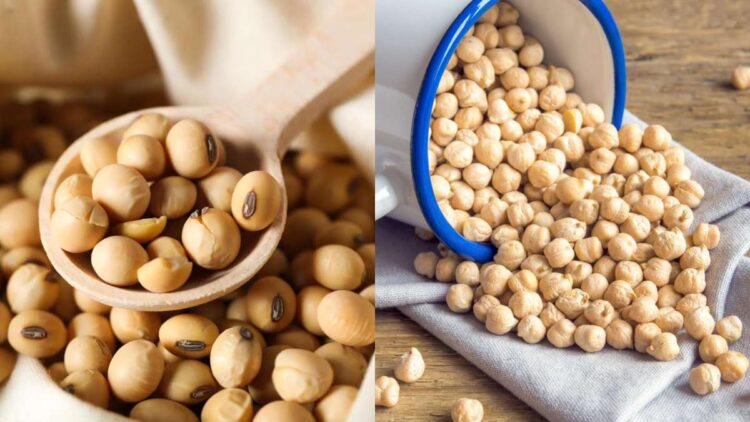Which is a healthier legume, chickpeas or soybeans?
Throughout the globe, legumes are a staple in many cuisines because they are a great source of fiber, vitamins, minerals, and plant-based protein. Soybeans and chickpeas are two of the many varieties of legumes that are particularly high in nutrients and provide a distinct range of health advantages. When routinely included in meals, these nutrient-dense legumes may help support a balanced diet. These legumes will fuel your body and taste senses whether you’re having a cool chickpea salad or a meaty tofu stir-fry. Examining these two legumes’ nutritional profiles will help us determine which is the healthier option.

Veggies
For a very long time, soy has been praised for its nutritional worth and adaptability. These tiny, spherical beans contain all nine of the essential amino acids required for human health, making them a complete protein source. Because of this, soybeans are a great source of protein for vegans and vegetarians. Moreover, omega-3 and omega-6 fatty acids, which are critical for heart health and general wellbeing, are among the many polyunsaturated fats that soybeans are high in. They also include a lot of fiber, which improves gut health and aids with digestion.
Soybeans are a noteworthy source of isoflavones, a kind of phytoestrogen. These substances have been investigated for possible health advantages, such as decreasing the risk of certain malignancies, heart disease, and menopausal symptoms. Soybeans are also an excellent source of iron, calcium, magnesium, and vitamin K, among other vitamins and minerals. These nutrients are essential for blood coagulation, energy metabolism, and bone health.
garbanzo beans
Garbanzo beans, also referred to as chickpeas, have become more and more well-liked in recent years because of their nutty flavor and adaptability in the kitchen. Chickpeas are an essential component of vegetarian and vegan diets because, like soybeans, they are a great source of plant-based protein and fiber. Chickpeas are high in complex carbohydrates, which provide a consistent flow of energy and aid with blood sugar regulation, in addition to protein and fiber. They are cholesterol-free and low in fat, which makes them heart-healthy choices.
Especially high in folate, a B vitamin required for cell division and DNA synthesis, are chickpeas. To avoid neural tube abnormalities in the developing foetus, it is imperative that pregnant women consume an adequate amount of folate. Moreover, chickpeas are a good source of manganese, which is important for wound healing and bone formation. Phosphorus is another important component that may be found in chickpeas. It is essential for the health of bones, kidneys, and the creation of energy. Chickpeas are also an excellent source of zinc, iron, and magnesium, all of which improve general health and wellbeing.
Which Is Healthier, Then?
Chickpeas and soybeans both have significant health advantages and may be beneficial additions to a diet that is well-balanced. Individual dietary choices, nutritional requirements, and culinary tastes ultimately choose which of the two to choose.
Because of their full amino acid profile and increased protein content, soybeans can be a better option if you’re trying to increase your protein consumption. Furthermore, because of their high isoflavone content, soybeans have special health advantages that make them an excellent choice for balancing hormones and heart health.
Conversely, chickpeas are excellent sources of vital minerals, such as phosphorus, manganese, and folate, and they have a reduced fat and calorie content. They are a fantastic option for blood sugar regulation and long-lasting energy since they are also a fantastic source of complex carbs.






